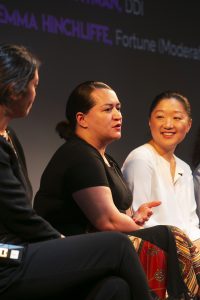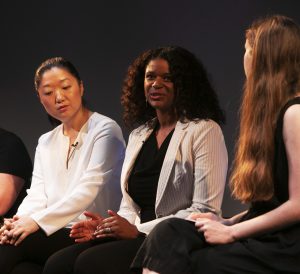What It Takes for Inclusion to Be More Than a Buzzword


At this point in the evolution of Corporate America, almost nobody questions the importance of diversity and inclusion. Studies have repeatedly shown that companies that rank in the upper quartile for gender and racial diversity are more likely to see greater returns than the industry average. Not only that, but companies with greater inclusion are linked with higher degrees of productivity and innovation.
But inclusion isn’t necessarily easy to achieve. Unlike diversity, which can be measured in numbers, inclusion is less tangible. It’s partly a feeling of belonging, of one’s voice being heard.
“We very much view it as everyone has an opportunity to be a valuable player of the team. But we also want to make sure that once you're on that team, you have equal access and opportunity to advance the game,” said Lauren Lopez, using a sports metaphor perhaps inspired by her role as global senior director of human resources for the National Basketball Association.
Lopez was among the speakers on a panel entitled “New Frontiers of Inclusion” at the From Day One conference June 19 in Brooklyn, where the panelists explored aspects of inclusion ranging from the wage gap to technology. Among the highlights:

Inclusive Leadership
Marisa Grimes, the director of inclusion and diversity at Mastercard, said that inclusion starts with leadership. Employees who step into leadership roles must see inclusion as yet another skill set to craft, just like building business acumen and executive presence.
“When we talk about what an inclusive leader looks like, we think about it in terms of someone who can build and maintain diverse teams,” Grimes said. “That's something that all of our leaders need to be able to do.”
To foster that growth, Grimes said her team has begun embedding inclusion in the leadership-development program. It has also trickled down into hiring practices. “We look for things like people who are intellectually curious; people who have an open mindset; people who demonstrate that they have self-awareness.” IQ and EQ, she said, are as important as “DQ,” or a “decency quotient.”
“Again, we see this as a muscle that needs to be exercised. It needs to be developed, and it needs to be maintained,” she added.
Jazmine Boatman, the general manager of New York operations at DDI, a leadership consulting firm, said that inclusion means “a leader who brings out the best in people.” That, she explained, is someone who creates a work environment where perspectives and feedback are welcome. With that in mind, her firm, which specializes in talent management, focuses on interpersonal and communication skills.
In hiring, leaders need to beware of “Mini-Me syndrome,” she said, in which recruiters look for people who went to the same school, for example, or have the same work experience.
“When we think about, from a business perspective, what we're competing against,” she said, “we're going to need more variety of perspectives in order to understand our customers, who ideally are getting more and more diverse.”
Equal Access to Benefits
For Tammy Sun, the co-founder of Carrot, a startup which helps companies develop fertility plans for employees, the service itself—accessing fertility care—informs her idea of inclusion. “For us, we think about ‘What does the modern workplace mean?’ and ‘What does the future of work mean when we think about families and how we define families?’”
That has inspired training in health care and fertility care for transgender clients, Sun said, and thinking about how different countries can perceive fertility care. “We think about inclusion from the perspective of equal access for everyone for fertility care,” she said. “In our world, we built a platform and program to try to offer that access.”
Emma Hinchliffe, an associate editor at Fortune who moderated the panel, asked Sun about her perspective as a company founder. “What are the challenges of working on inclusion at a smaller company versus a large global company?” she asked.
Carrot was launched with an inclusive nature, Sun said. More than half of the employees are female, and her co-founders are both male and female, from different work backgrounds. With a smaller size, the company is nimble in identifying issues—and trying to fix them.
“Because of the way we operate the business and the leadership styles that are brought to the table, we have seen our company grow in a very diverse and interesting way across every single sector: age, sexual orientation, gender,” she said.

Tech for Inclusion
Increasingly, new tech tools have emerged to help companies foster more inclusion in their workplaces. At the NBA, artificial intelligence has made strides in the recruitment space, with better systems to eliminate hiring biases by covering up last names on applications, and singling out skill sets and experiences needed to do a specific job.
“I'm really supportive of that, not only as someone who has recruited for years, but also a Latina female, who has had similar struggles in terms of getting interviews, or applying to roles and not hearing back,” she said. “It's important [for recruiters] to be able to stick to what you need to know.”
Lopez said that when her job was focused on recruiting talent, she placed less emphasis on formal education, and more on life experience. Utilizing AI to foster that approach, she said, is a huge help.
At DDI, Boatman said her team is exploring virtual reality as a way to expose employees to situations they may not be familiar with. “You can put yourself in the experience of someone who is excluded from a meeting, where you're not being heard, people keep talking over you, and there's verbal and non-verbal cues,” she said. “You're actually at the table as that person, and see that experience.”
The reactions afterward, she said, have been “really powerful.” They help break down barriers for people who may have trouble understanding inclusion as an abstract concept. “Everyone had a similar experience, so we can talk about how that made you feel,” she said.
The Wage Gap
Hinchliffe asked the panelists how the gender wage gap intersects with inclusion.
Sun said that a benefit like fertility care becomes part of the wage gap, “when you think about who has access and who doesn't,” she said. “If you don't have that access at work as a fundamental part of your health-care coverage, that means that you are paying for it somewhere else.” Sun said she had to pay $40,000 herself to freeze her eggs—an experience that inspired her to start Carrot.
The NBA’s Lopez said she hopes that going forward, employers focus more on the entire life cycle of an employee. If companies want their employees to be more worldly and a valuable team asset, she said, they have to think about student loan debt that may be preventing employees from traveling. Or paying for quality day care, she added, so employees can show up “with a clear mind day-to-day to do your job.”
“Those are the things that I think are extremely important for inclusion,” she concluded. When companies leave them out of the picture, “they lead to the inequality we see in work.”
In a following session, Ellie Bertani, senior director of learning strategy and innovation for Walmart, talked with Rachel Carlson, CEO of Guild Education, about how companies like Walmart are combating the student-debt crisis with new education programs.
John Surico is a freelance journalist and researcher, based in New York City. His reporting has appeared in the New York Times, VICE, and a number of other local and national publications
The From Day One Newsletter is a monthly roundup of articles, features, and editorials on innovative ways for companies to forge stronger relationships with their employees, customers, and communities.